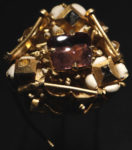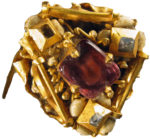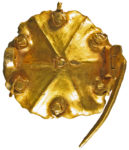 The Victoria & Albert Museum has acquired a medieval brooch that is the only one of its kind ever discovered in the UK. Only seven of them are known to exist in the world. It was discovered by metal detectorist Justin Owens at a 2017 rally on a farm that was once a royal hunting grounds near Brigstock, Northamptonshire. It was only four inches under the surface and so caked with mud that Owens at first thought it was a bottle cap or some other piece of trash. Cleaning revealed it was an extremely rare late medieval brooch of gold and jewels.
The Victoria & Albert Museum has acquired a medieval brooch that is the only one of its kind ever discovered in the UK. Only seven of them are known to exist in the world. It was discovered by metal detectorist Justin Owens at a 2017 rally on a farm that was once a royal hunting grounds near Brigstock, Northamptonshire. It was only four inches under the surface and so caked with mud that Owens at first thought it was a bottle cap or some other piece of trash. Cleaning revealed it was an extremely rare late medieval brooch of gold and jewels.
 The front face of the brooch is a triangular setting outlined by three gold bars with a central rectangular gemstone, almost certainly a spinel, in a four-prong mount. Around the stone are alternating flower and bow shapes with twisted gold wires filling gaps. At the three corners of the triangle are are box bezels topped with a pointed gemstone giving them a pyramidical shape. One of the three is missing its gem point. The surviving two are diamonds. White enamel balls accent the piece and there would originally have been pearls, now lost.
The front face of the brooch is a triangular setting outlined by three gold bars with a central rectangular gemstone, almost certainly a spinel, in a four-prong mount. Around the stone are alternating flower and bow shapes with twisted gold wires filling gaps. At the three corners of the triangle are are box bezels topped with a pointed gemstone giving them a pyramidical shape. One of the three is missing its gem point. The surviving two are diamonds. White enamel balls accent the piece and there would originally have been pearls, now lost.
 The front face is mounted to a roughly circular gold back plate divided into six pie slices. At the center of the outer edge of each wedge is a rivet keeping the setting elements in place, mounted to the back plate. There’s another rivet in the middle where the six divides meet. It holds the central gem in place. The pin is intact, hinged to the back plate. The style of design dates it to between 1420 and 1600.
The front face is mounted to a roughly circular gold back plate divided into six pie slices. At the center of the outer edge of each wedge is a rivet keeping the setting elements in place, mounted to the back plate. There’s another rivet in the middle where the six divides meet. It holds the central gem in place. The pin is intact, hinged to the back plate. The style of design dates it to between 1420 and 1600.
James Robinson, Keeper of Sculpture, Metalwork, Ceramics and Glass at the V&A, said: “This intriguing and exquisite late medieval cluster brooch is a rare survivor with a tantalising story to tell.
“It’s sculptural design, exceptionally fine gold and enamel work, stunning diamonds, central cabochon spinel and pearls (now lost), all express burgeoning opulence and extreme wealth.
“It would have been made for someone from the highest echelons of society. The loss of some diamonds and the brooch’s severely bent pin belie the visible trauma it would have suffered when it was likely ripped off its wearer during the thrill of a hunt.
“It makes a truly captivating and unique addition to our world-class jewellery collection, which traces the story of jewellery in Europe from ancient times to the present day.”
After a painstaking conservation using the most delicate of tools including pheasant and ostrich feathers, the brooch will go on display in the V&A’s Judith Bollinger Jewellery Gallery alongside the silver, sapphire and diamond coronet Prince Albert had made as wedding gift for Queen Victoria.
The three gold bars must have held ribbons or something.
…or beads or feathers. They look more utilitarian than decorative.
Frankly, my initial personal assessment of that “cluster” had been that of a terrible “soldering accident”. Now, having revised my initial impression, there might indeed have been “ribbons”. Also, I reckon that this piece sat on some form of hat, like the golden cluster on this gentleman’s hat from 1531, and a typical hunting scene might have been similar to this one.
I have seen this item on several different sites, and all of them referenced the intact pin and noted that it had apparently been wrenched from the wearer with some force. None of the sites pictured this, and I told my husband that it would probably appear on The History Blog in all its glory. I was not disappointed! Thank you.
Would you happen to know where the other ones are and what they look like in comparison?
The scallops in the bars’ supporting brackets suggest that there were two beads, maybe amber or some other delicate substance, on each bar.